MXA RACE TEST: THE REAL TEST OF THE 2023 KTM 350SXF
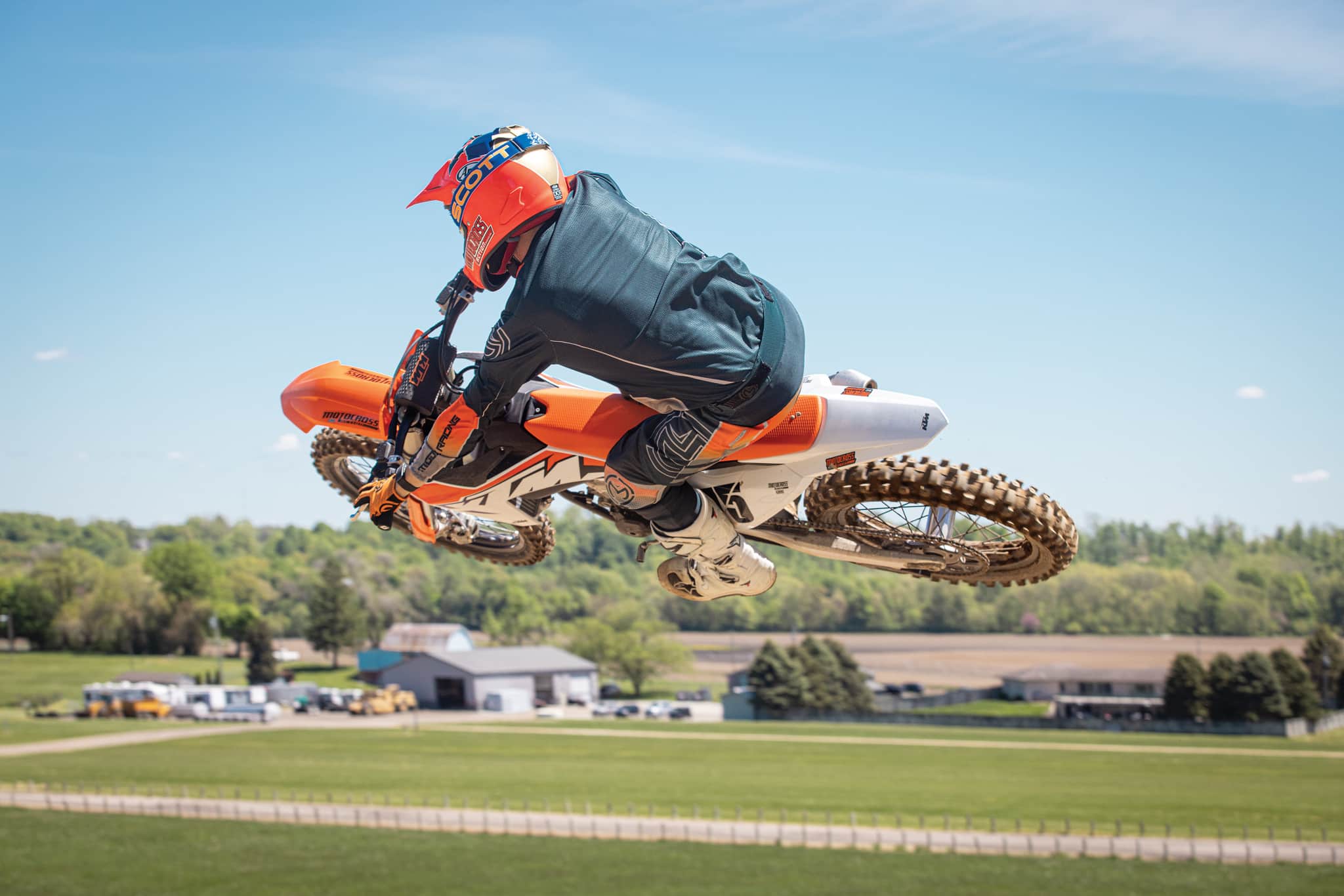 THE GEAR: Jersey: Moose Racing Sahara, Pants: Moose Racing Sahara, Helmet: Arai VX Pro-4, Goggles: Scott Fury, Boots: Alpinestars Tech 7.
THE GEAR: Jersey: Moose Racing Sahara, Pants: Moose Racing Sahara, Helmet: Arai VX Pro-4, Goggles: Scott Fury, Boots: Alpinestars Tech 7.
Q: FIRST AND FOREMOST, IS THE 2023 KTM 350SXF BETTER THAN THE 2022 KTM 350SXF?
A: Yes, but not right away.
Q: WHAT’S NEW ON THE 2023 KTM 350SXF?
A: Compared to last year’s bike, the $10,699 2023 KTM 350SXF is wildly different.
Engine. The KTM 350SXF engine is based on the KTM 250SXF bottom end. To centralize mass and reduce chain torque, the engine was tilted 2 degrees backwards and the countershaft sprocket positioned 3mm lower. Dropping the countershaft sprocket cleans up the chain line and works as an anti-squat measure to keep the frame from being drawn downward by chain torque.
Frame. Both the hydro-formed chromoly steel frame and aluminum/injection-molded, polyamide carbon subframe are all new for 2023. The biggest change on the chassis is that the frame’s backbone and top shock mount aren’t connected anymore. Instead of a forged shock tower being welded to the frame’s backbone, it is connected to the downward frame spars on the side of the frame to redirect energy into the central mass of the chromoly frame. The steering head has also been reinforced with forged plates top and bottom for improved strength and rigidity. The 2023 KTM 350SXF also received a stiffer, die-cast, hollow aluminum swingarm equipped with a downsized 22mm rear axle.
Rider triangle. Even with a new frame, the rider triangle’s geometry maintains the same relationship between the footpegs, seat and handlebars as the 2022 and earlier 350SXFs.
Electronics. All of the electronic switchgear has been updated. On the left handlebar is a multi-switch that allows the rider to choose between the stock map, aggressive map, Traction Control, Quick Shift and Launch Control (by pressing the Quick Shift and Traction Control buttons at the same time). On the top triple clamp is a new hour meter that also functions as the FI diagnostic light. On the right handlebar are the electric start button and kill button.
Suspension. WP reworked the forks and shock for 2023 with the goal of making the damping firmer at both ends of the stroke. As far as mechanical changes go, the WP XACT air forks got new valving and Hydro-Stop bottoming cones, while the rear shock and shock spring were shortened 15mm. Even though the shock and spring are shorter, the shock’s stroke is unchanged from 2022, and the spring rate is still 45 N/mm. The shock linkage had its pivots moved up to raise the link arms farther off the ground.
The big news on the suspension front is that all the compression and rebound clickers, on both the fork and shock, can be adjusted by hand. No need for a screwdriver to adjust compression or rebound; just turn the dial. The rebound clicker on the bottom of the shock clevis is a little hard to adjust by hand because the shock linkage arms can block access.
 First introduced in 2011 as a rather mediocre package, the KTM 350SXF has improved every year since.
First introduced in 2011 as a rather mediocre package, the KTM 350SXF has improved every year since.
Q: HOW DOES THE 2023 KTM 350SXF RUN ON THE TRACK?
A: It is a lot stronger than last year from low to mid. The previous 350 engine always seemed down on power as it worked its way towards the midrange. The 2023 engine jumps out of the corners and pulls harder into the midrange. It pulls more like a 450 when exiting corners and yet still revs to the moon like a 250F! Once in the meat of the midrange and top-end power, the 2023 KTM 350SXF runs great. It delivers the best of both worlds. It picks up quickly down low, pulls steady through the middle and revs to an amazing 13,400-rpm rev limiter. To get the best out of the KTM 350SXF engine, you have to rev it. MXA’s advice to all first-time 350SXF riders is, “Don’t shift.” Peak horsepower is way, way, way up on top, so shifting early is the same as giving up horsepower. Wait for the rev limiter to kick in, and then wait another beat before shifting. 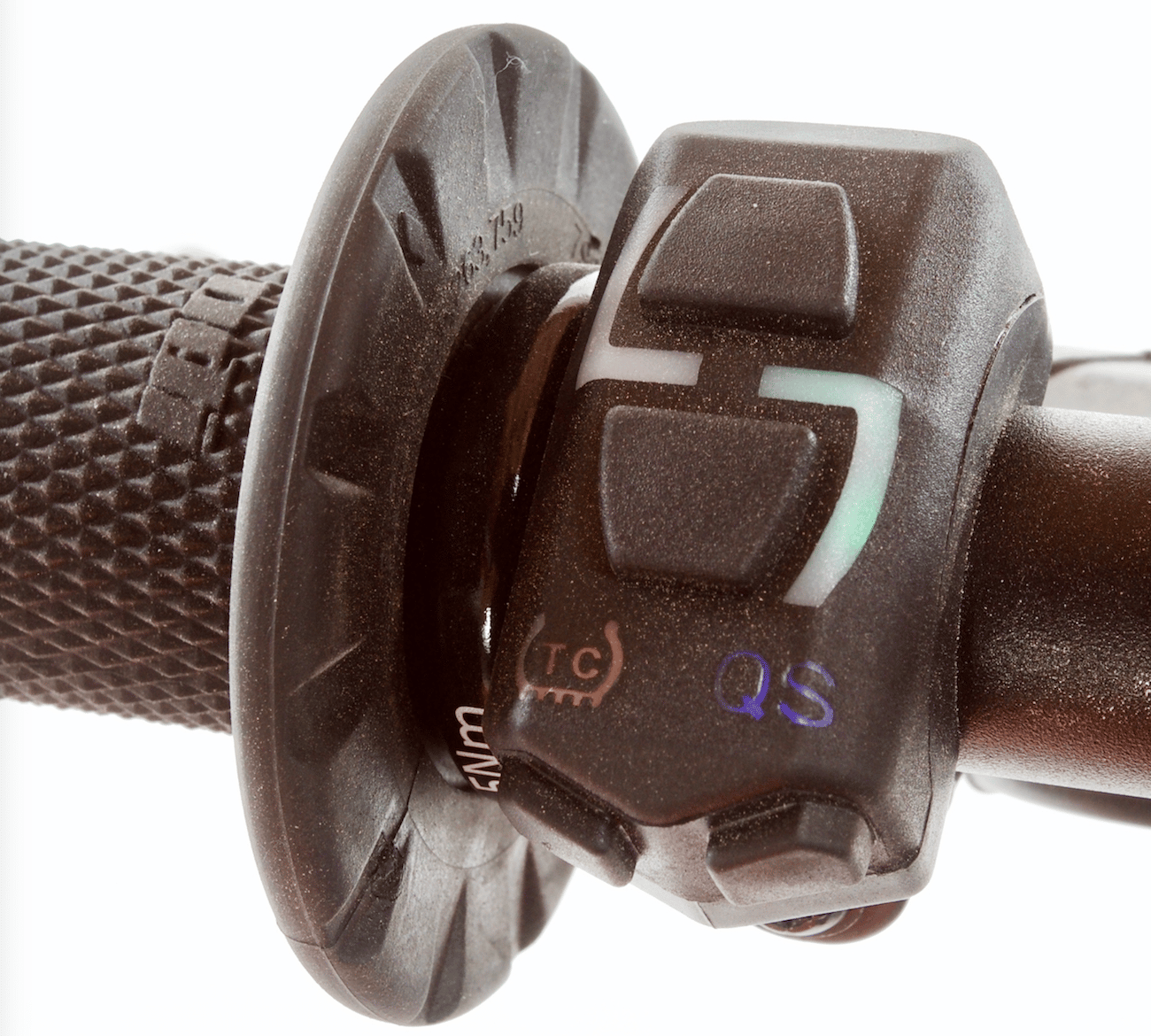 The top button is the stock map, the lower button is the aggressive map, the TC button is Traction Control, the QS button is Quick Shit and if you press TC and QS at the same time you get Launch Control.
The top button is the stock map, the lower button is the aggressive map, the TC button is Traction Control, the QS button is Quick Shit and if you press TC and QS at the same time you get Launch Control.
Q: WHAT DO YOU NEED TO KNOW ABOUT THE MAPS AND ENGINE AIDS?
A: As for mapping, most of our test riders preferred Map 2 (the lower map button). It was more exciting, more aggressive, and snappier off the bottom end. It erased any memories of the slow developing 350 power of the past. The stock map (upper map button) was perfect for Novice and Vet riders who want the power to develop at a more metered pace; however, no matter how you want the power to come on from low to mid, once the 350SXF engine gets in the upper ranges it turns into a high-rpm rev monster.
Traction Control has its uses, but it is largely track specific. If you put the 350SXF in Traction Control on a loamy, sandy or deeply ripped track, it will never kick in. You don’t need Traction Control when there is optimum traction. Save Traction Control for muddy, rainy or rock-hard days when the rear tire might spin freely. Traction Control works by reading “runaway revs” when the tire spins. If it doesn’t spin, Traction Control is useless.
Quick Shift works by cutting the ignition spark the instant you upshift from second through fifth gears. This lessens the load on the transmission to make clutch-less shifts possible. There is nothing new about Quick Shift. It has been on street bikes for a long time, but this is the first time it has appeared on a motocross bike. The MXA test riders love it on long, high-speed starts (like Glen Helen’s 70-mph rush to the banked first turn), but they don’t love it as much on the track. It is almost flawless on shifts when the engine is wide open, but in half-throttle situations or when you slow on a jump face, Quick Shift makes it feel like the engine has bogged. Largely psychological, the boggy sound is enough to turn riders against using QS all the time.
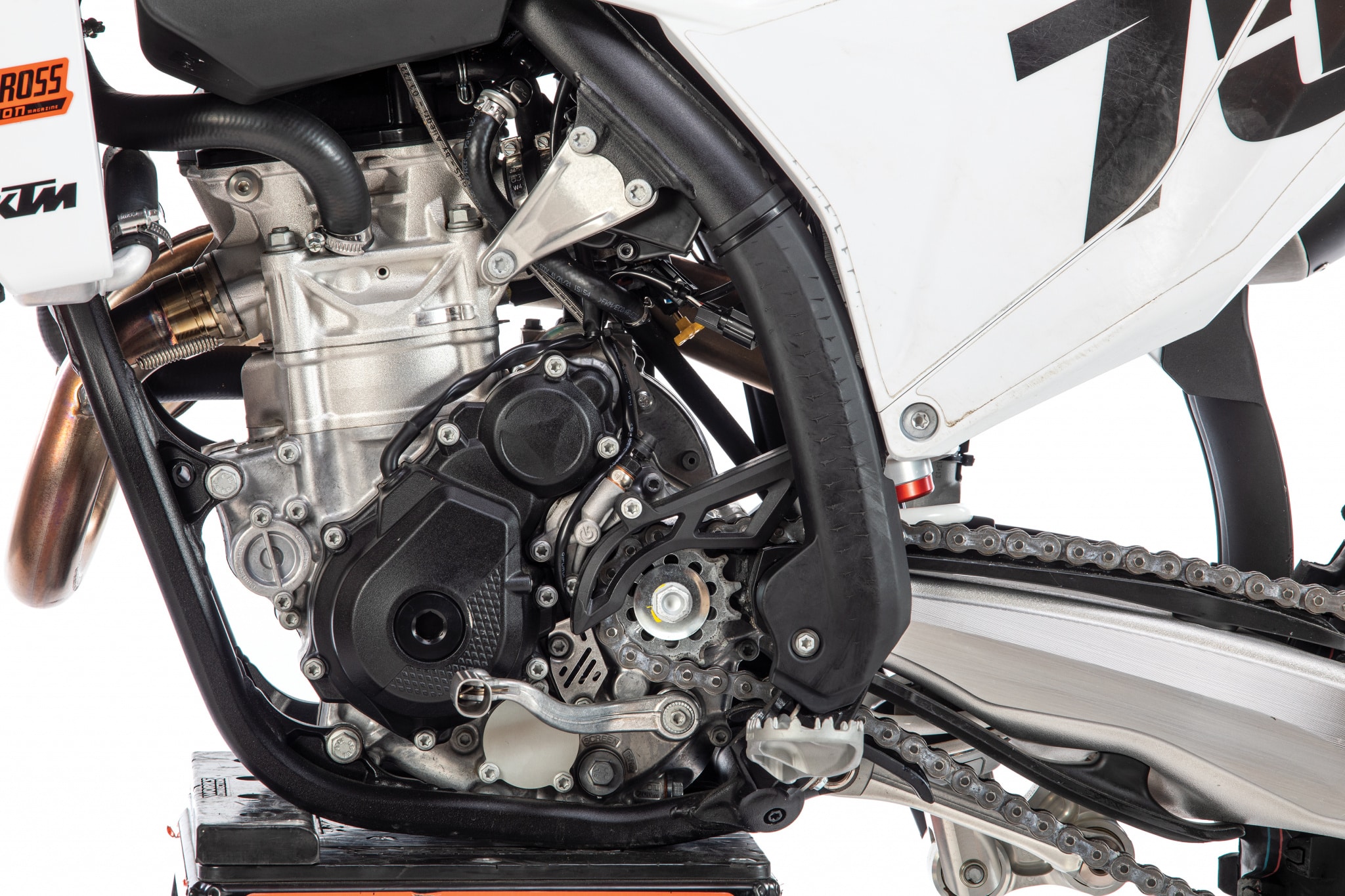 The KTM 350SXF powerplant is much stronger from low-to-mid than last year, which helps on corner exit and works seamlessly to jump the engine into its amazing top-end rev.
The KTM 350SXF powerplant is much stronger from low-to-mid than last year, which helps on corner exit and works seamlessly to jump the engine into its amazing top-end rev.
Q: HOW LONG DOES IT TAKE FOR THE 2023 350SXF TO BREAK IN?
A: Surprise! The 2023 KTM 350SXF didn’t feel very good when we first started riding it. The new bike delivered a completely different feel from what we were used to. Its more rigid frame and anti-squat chassis made it feel harsh, hard and stiff. Lucky for us, we remembered that back in 2018 we had the same issues when KTM added reinforcing gussets to the head tube. Test riders couldn’t run the suspension settings that they loved in 2017. But, after a couple hours of track time, everything seemed to return to normal.
Thankfully, the MXA wrecking crew didn’t give up on the KTM 350SXF in the first hours of harshness. The more time we put on the bike, the better it got. Our 2023 KTM 350SXF came full circle for us at the 10-hour mark. The engine was free revving. The WP XACT air forks were plusher, and, most important, the chromoly steel frame became more resilient.
We think that KTM has an uphill battle convincing buyers that there is nothing wrong with a bike that is so rigid for so long, especially for riders who probably don’t ride 10 hours in a month or two; however, with each hour, the frame, forks and engine will feel better. Once the frame has 10 hours on it, it feels plush.
 The 2023 KTM 350 engine is a thrill ride. It pulls hard through the middle and revs like a banshee.
The 2023 KTM 350 engine is a thrill ride. It pulls hard through the middle and revs like a banshee.
Q: HOW DOES THE 2023 350SXF HANDLE ON THE TRACK?
A: After the dreadfully long break-in period, the 2023 KTM 350SXF handles great. The straight-line stability and suspension action under braking at corner entrance are vastly improved. With the backbone separated from the shock tower and the energy of hard landings and big bumps being redirected down the parallel frame spars (instead of into the backbone). The frame dissipates the blunt force trauma to deliver less harshness to the rider. Long story short, the 2023 bike is better at soaking up braking and acceleration bumps once it is broken in.
The 2023 KTM 350SXF’s steel chassis has a naturally resilient feel in motion. The 2023 KTM 350SXF handles like a dream. Its proven frame geometry allows it to respond quickly and accurately to rider input. It doesn’t suffer from unwanted oversteer or understeer. It tracks straight and slices through corners.
Q: WHAT IS THE SECRET TO MAKING THE 2023 WP XACT AIR FORKS WORK GREAT?
A: The key to success with the 2023 KTM 350SXF air forks is to find your own personal air pressure. This is easy to do. Put a zip-tie around the right fork leg and go ride. When you get back to the pits, look at the position of the zip-tie on the fork leg. If it is more than 2 inches above bottoming, you need to lower the air pressure. If it has bottomed out, you need to add air pressure. Keep changing the air pressure until the zip-tie is 1-1/2 inches above bottoming. That air pressure will be your perfect spring rate.
Once you have found your perfect air pressure, make all damping adjustments with the fork’s compression and rebound clickers. Too many riders think that they can change the compression and rebound damping by changing the air pressure. Not so! The air pressure is the fork spring. The clickers control damping. Don’t mix the two up.
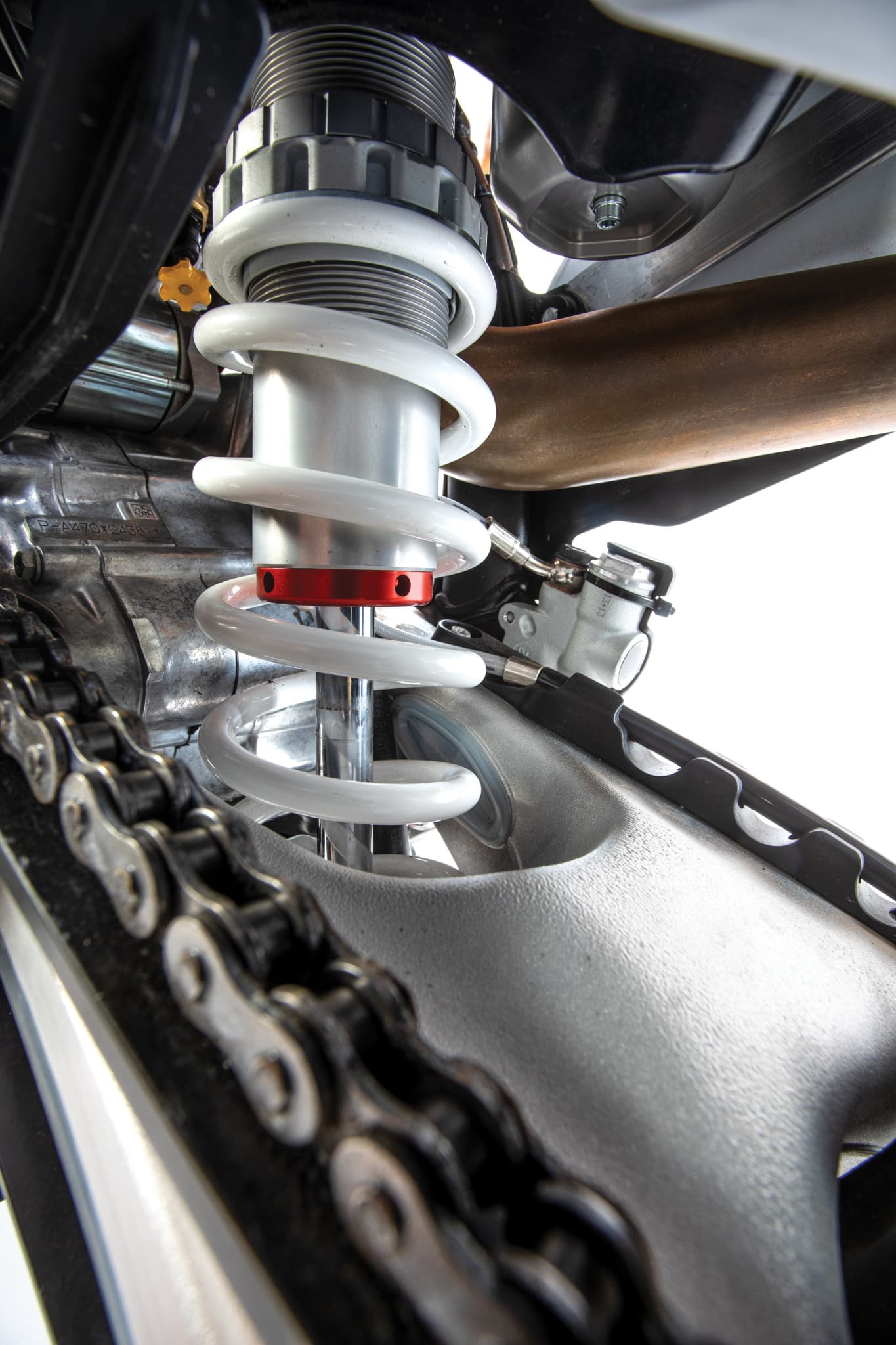 The rear shock has a shorter body and spring, but the same travel. The MXA test riders wanted firmer damping at the end of the stroke.
The rear shock has a shorter body and spring, but the same travel. The MXA test riders wanted firmer damping at the end of the stroke.
Q: WHAT DID WE HATE?
A: The hate list:
(1) Seat height. Motocross bikes keep getting taller. If you are under 5-foot-9, your feet won’t touch the ground on the 350SXF; however, if you want a lower 350, buy the 2023 Husqvarna FC350. It is an inch lower at the rear of the seat.
(2) Radiator cap. The new plastic minicycle-style radiator cap is a downgrade. It has come loose on us after a long moto, which is odd because with its small diameter it is very hard to twist open. The factory team runs the traditional-style cap.
(3) Bodywork. The rear fender has to be removed to get the side number panels off. That is wrong on so many levels.
(4) Weight. The 350SXF gained several pounds; it’s now 224 pounds.
(5) Slide-N-Guide. The new position of the countershaft sprocket, new frame and new swingarm don’t work well with the chain buffer pad. It wears out fast at the front of the swingarm, right next to the counter shaft sprocket. We recommend TM Designworks.
(6) Orange rings. Don’t rely on the orange rings to measure fork travel. They wear out quickly, and when they wear out, they fall to the bottom of the fork legs. We use a zip-tie.
(7) Price. No matter how much technology is added to the bike, $10,700 is a high price to ask.
(8) Spokes. The 2023 spokes are worse than before.
(9) Front fender. We like the wider front fender, but the fork guards can hit the inside edge of the fender at full travel. Normally, it just chips the plastic fender, but this could be troublesome if one or the other plastic parts break.
Q: WHAT DID WE LIKE?
A: The like list:
(1) Brembo hydraulic clutch. We like the “pop” feel of the Brembo master cylinder.
(2) Brembo brakes. Someday, Nissin will catch up to Brembo when it comes to well-modulated, powerful, one-finger braking, but it isn’t going to happen in 2023.
(3) Air filter. We love how foolproof it is to put a KTM air filter cage into the airbox. No gymnastics and no tools required.
(4) Gasoline. The KTM 350SXF is tuned to run on 91-octane American fuel. If you modify your engine, increase the compression, or switch black boxes, you might need better fuel. Until then, buy the highest-octane pump gas that you can find at the busiest gas station in your town.
(5) Vented airbox. We run the vented airbox cover on all but very dusty or very rainy days. It makes a noticeable difference in throttle response from low to mid. We cover the vents with duct tape before washing the bike. Twin Air makes a plastic airbox cover that stops water from getting into the engine when power washing it.
(6) Shock collar. The new shock collar is a big improvement over the old one. Thank you, WP!
(7) Air forks. The WP XACT air forks work great if you take the time to set them up for your weight and speed.
(8) Chain slack. It looks wrong. It feels wrong. And it can’t be right. But, KTM says to run 70mm of chain slack. We do it because 60mm of chain slack looks wrong in the opposite direction.
(9) Platform sharing. If you’re scared of buying a first year model, but want a new 350, you should buy a 2023 GasGas MC350F. It is based on the 2022 frame, subframe and engine with softer suspension and sleeker plastic.
Q: WHAT DO WE REALLY THINK?
A: Hallelujah! We firmly believe that the KTM 350SXF is one of the three best all-around motocross bikes you can buy. The other two are the Husqvarna FC350 and the GasGas MC350F.
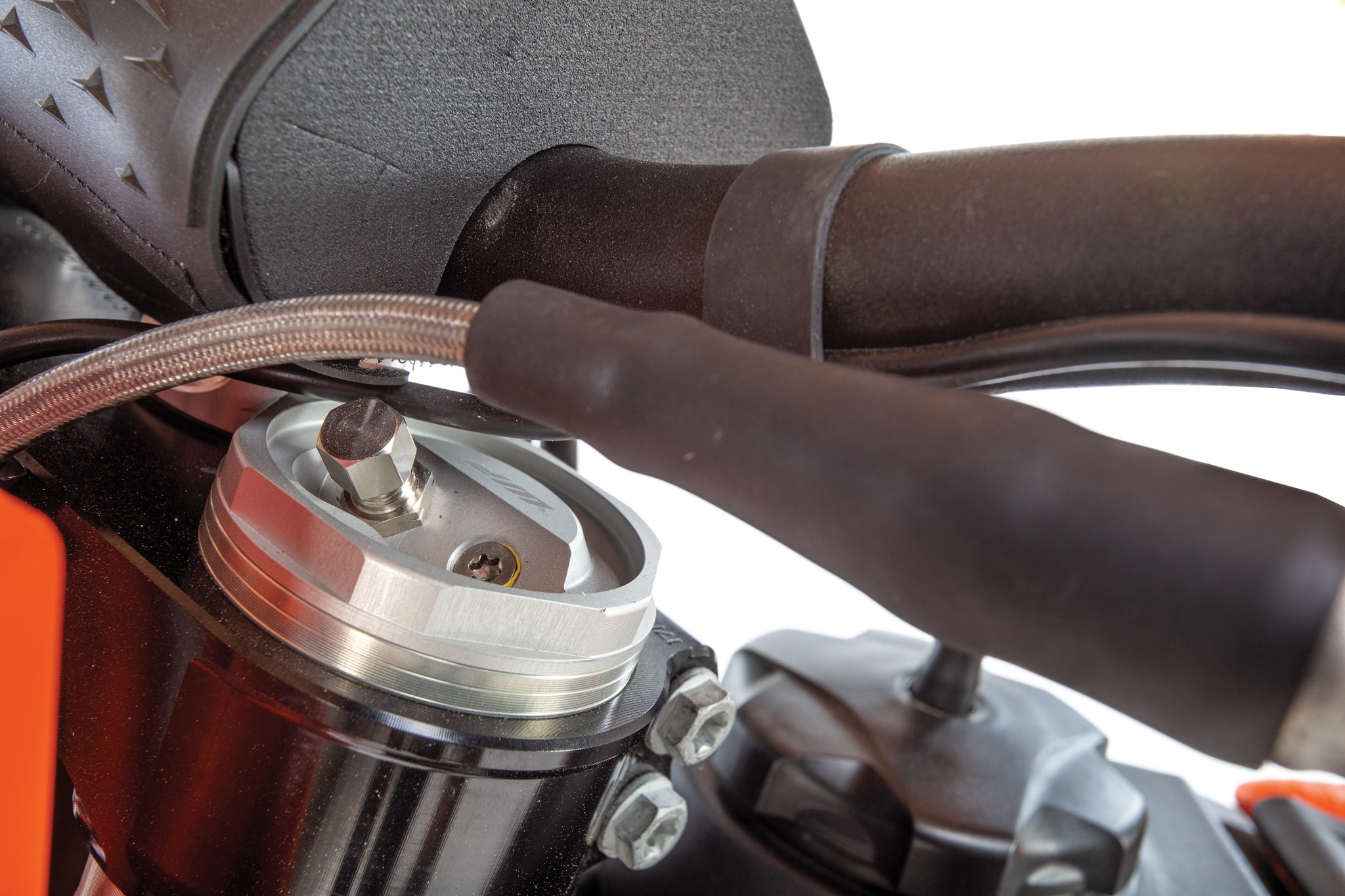 The WP XACT air fork works well if you find your personal air pressure and make all damping changes with the clickers. We slide the forks up and down in the clamps to fine tune the handling.
The WP XACT air fork works well if you find your personal air pressure and make all damping changes with the clickers. We slide the forks up and down in the clamps to fine tune the handling.
MXA’S 2023 KTM 350SXF SETUP SPECS
This is how we set up our 2023 KTM 350SXF for racing. We offer it as a guide to help you find your own sweet spot.
AER FORK SETTINGS
The 2023 WP XACT air forks will change your mind about air forks—if you learn how to make them work. WP applied common sense to the air and oil spikes inside the fork to produce the best air fork imaginable (and many factory riders are now running air forks, including 2021 AMA 450 National Champion Dylan Ferrandis). The new-generation WP XACT forks offer the feel of a coil-spring fork while being 3 pounds lighter. To get that feel, you have to find your perfect air pressure and do all additional tuning with the clickers. For hardcore racing, we recommend this fork setup for an average rider on the 2023 KTM 350SXF (stock specs are in parentheses):
Spring rate: Pros (155 psi), intermediates (150 psi), fast novices (145 psi), vets (140 psi)
Compression: 15 clicks out (12 clicks out stock)
Rebound: 15 clicks out (12 clicks out stock)
Fork-leg height: Third line
Notes: We have liked the performance of the WP XACT air forks for the last three model years; however, they do require more effort than coil spring forks. Always reset your air pressure before you ride and bleed the air screws in the morning. Then, if your bike is sitting in the sun, recheck your forks by monitoring any pressure increases throughout the day. We check our fork pressure before every race.
WP SHOCK SETTINGS
Most MXA test riders added more high-speed compression and more rebound, but, as a rule, MXA test riders don’t stray far from the stock 15 clicks out on low-speed compression, relying on the high-speed and rebound adjustments to have a crossover effect on the whole shock. Our only quibble with KTM’s rear suspension is that the shock doesn’t have enough damping at the end of the stroke to keep the shock from bottoming. We think the rising rate needs to be changed for 2024, but as for now, if you feel the shock clanking, add more low-speed compression. For hardcore racing, we recommend this shock setup for the 2023 KTM 350SXF (stock specs are in parentheses):
Spring rate: 45 N/mm
Race sag: 105mm
Hi-compression: 1-1/4 turns out (1-1/2 turns out stock)
Lo-compression: 15 clicks out
Rebound: 10 clicks out (15 clicks out stock)
Notes: Our shock linkage was sticking. The new-generation KTM/Husky models have issues with the needle bearings walking out of the inside of the linkage’s bell crank and hindering the movement. A slow-moving linkage won’t allow the shock to work properly, and it causes the rear end to feel dead. Check to see if you’re having this issue by removing the bell crank and checking to see if it rotates smoothly or gets hung up. If your linkage is hanging up, replace the needle bearings with a new cage bearing (KTM part number 58033097000).


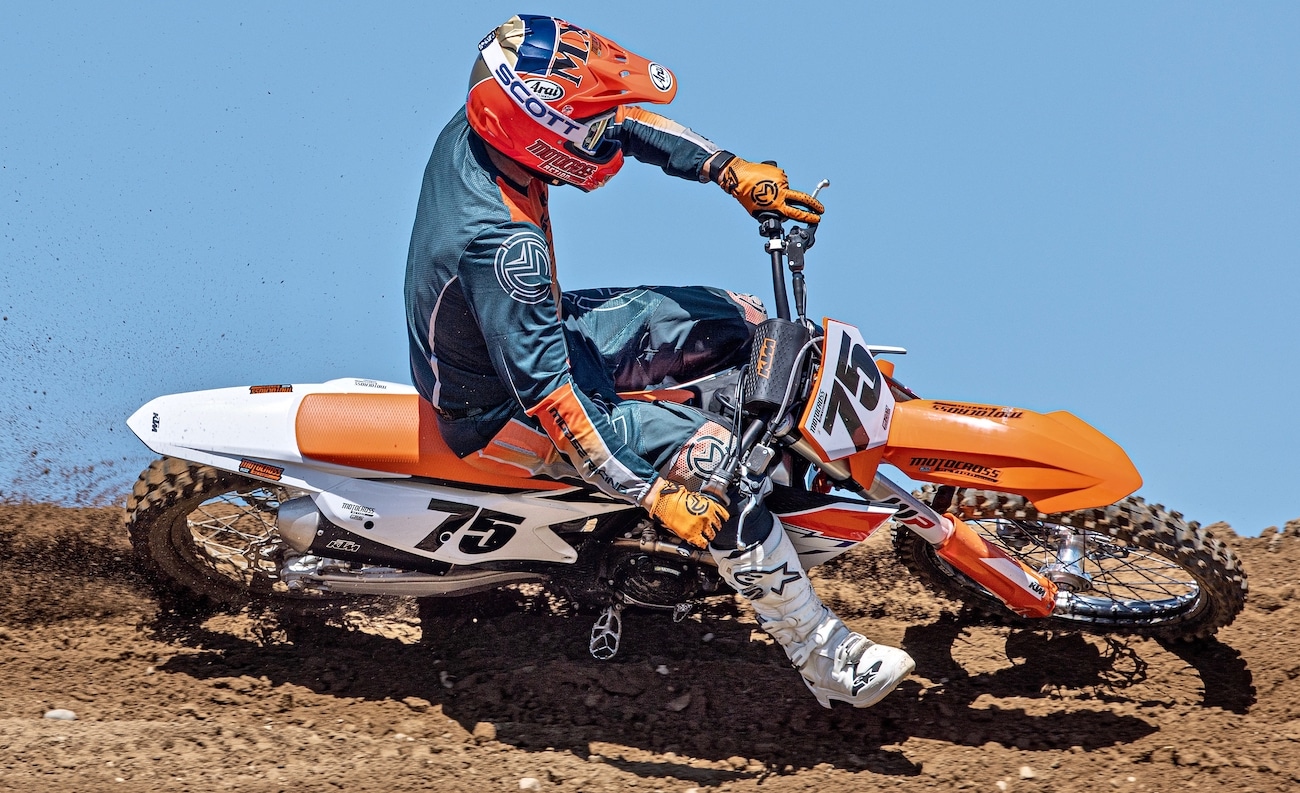
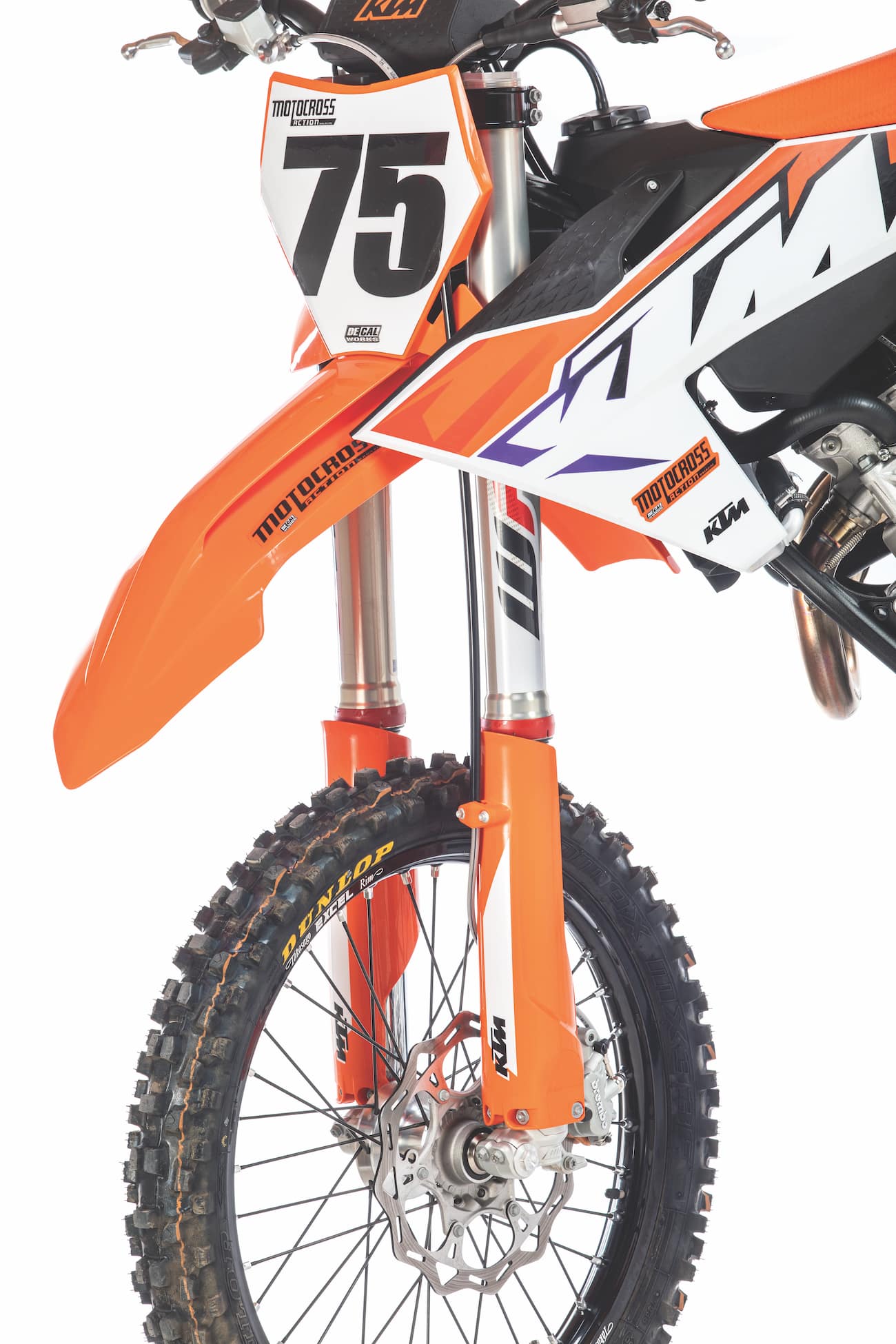

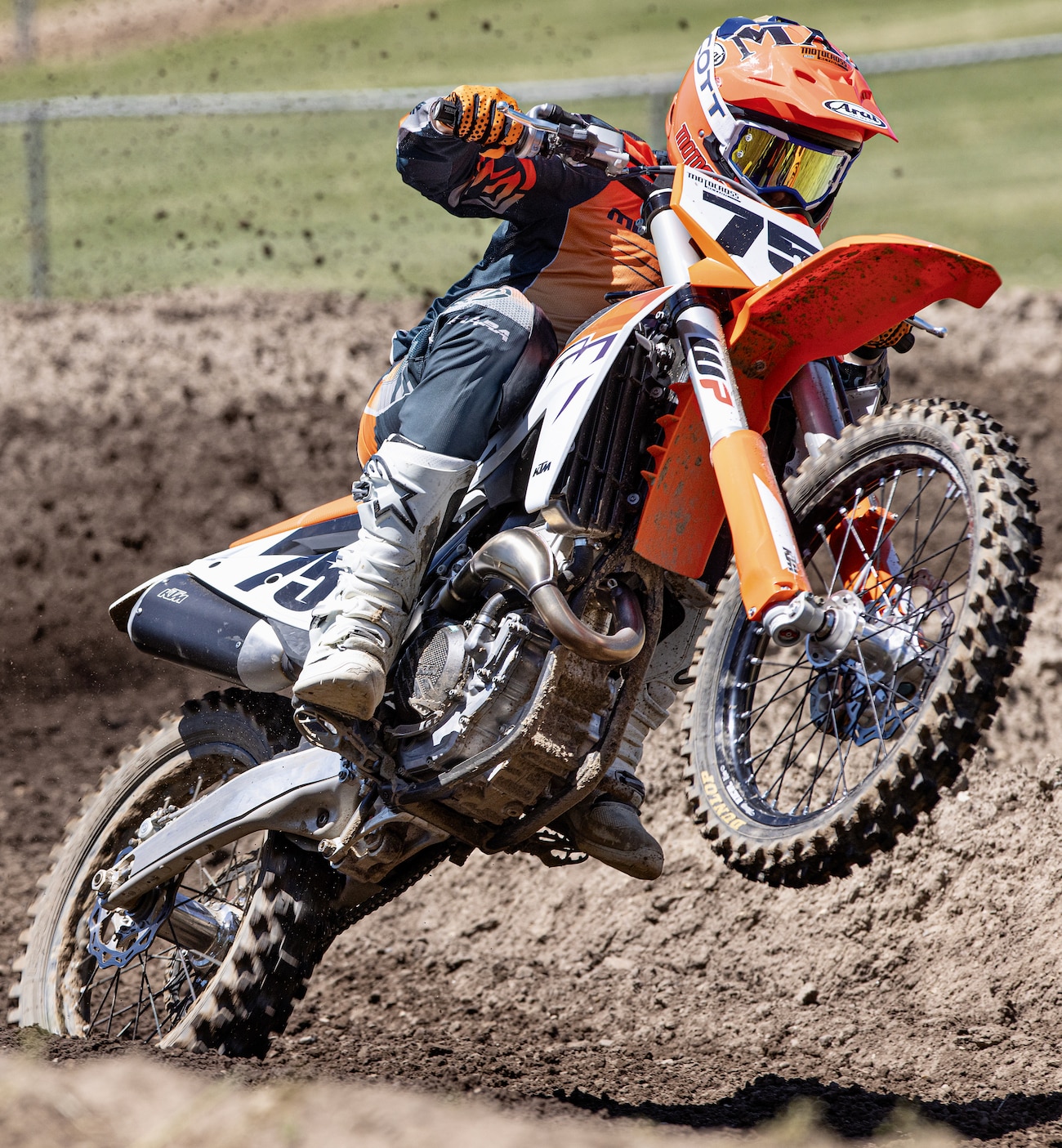



Comments are closed.